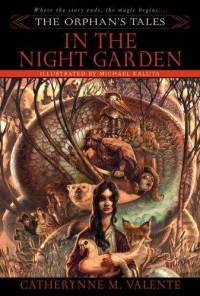 I realized, after I had begun reading Catherynne M. Valente‘s The Orphan’s Tales Volume 1: In the Night Garden (Bantam Spectra, 2006; all quotations are taken from this edition), that discussing both volumes of The Orphan’s Tales might be a tricky exercise. The novels were published as a duology but are essentially one hefty novel split in two, and I wondered if discussing them separately might become redundant. However, once I was several chapters into In the Night Garden, I knew the two topics in these novels I wanted to write about were Valente’s structure and style. This post will focus on the structure, using In the Night Garden, and my next post will focus on the style, using the second volume, In the Cities of Coin and Spice. Warning: Spoilers to follow.
I realized, after I had begun reading Catherynne M. Valente‘s The Orphan’s Tales Volume 1: In the Night Garden (Bantam Spectra, 2006; all quotations are taken from this edition), that discussing both volumes of The Orphan’s Tales might be a tricky exercise. The novels were published as a duology but are essentially one hefty novel split in two, and I wondered if discussing them separately might become redundant. However, once I was several chapters into In the Night Garden, I knew the two topics in these novels I wanted to write about were Valente’s structure and style. This post will focus on the structure, using In the Night Garden, and my next post will focus on the style, using the second volume, In the Cities of Coin and Spice. Warning: Spoilers to follow.
Valente strings together interrelated stories throughout In the Night Garden, but her structure alludes to older literary antecedents rather than the contemporary story cycle (an example of which I will discuss in a few weeks, Christopher Barzak’s The Love We Share Without Knowing). In the Night Garden is a descendent primarily from the Middle Eastern The Thousand and One Nights (ca. 1500) and perhaps the Indian Panchatantra (ca. 200-400) but also from Giovanni Boccaccio’s Decameron (1353), Giovanni Francesco Straparola’s Le piacevoli notti (The Pleasant Nights; 1550-1553), and Giambattista Basile’s Il pentamerone (originally, The Story of Stories; 1634-1636). Each of these ancestral works has a framework narrative in which people, for various reasons, tell each other stories, and—in the cases of The Thousand and One Nights and the Panchatantra—often telling stories within stories within stories. Valente has appropriated a similar framework for The Orphan’s Tales: an unnamed girl is exiled to the Sultan’s Garden to live because of “a strange and wonderful birthmark, in that her eyelids and the flesh around her eyes were stained a deep indigo-black” (3), which the people of the Palace believe marks her as a demon or at least a spirit; one of the Sultan’s young unnamed sons comes to her in the Garden one night and she tells him the beginning of a story, which is tattooed on the inside of her eyelids. The boy’s sister, Dinarzad, complicates the frame narrative over the course of the novel by trying to keep the boy away from the spirit girl (I should note that the name “Dinarzad” looks very similar to the name of Scheherazade’s sister, Dinazade, in The Thousand and One Nights).
In the Night Garden is divided into two Books: The Book of the Steppe and The Book of the Sea. The Book of the Steppe is framed around the girl telling the boy “The Tale of the Prince and the Goose,” The Book of the Sea around “The Pale Girl’s Tale.” The frame narrative sections are called generally either “In the Garden” or “In the Palace”; the entire first page of these frame sections is literally framed with a border and printed over a damask watermark, for lack of a better term. Similarly, the title of each story the girl tells is likewise bordered with the same damask watermark underneath, but only the title. The effect is not only visually compelling but gives the reader immediate visual cues as to the return to the frame narrative.
Below I’ve outlined the structure for the first half of In the Night Garden, The Book of the Steppe, to more clearly indicate the story-within-a-story-within-a-story structure, or what we might also call a nesting-doll structural conceit:
Prelude
The Tale of the Prince and the Goose
In the Garden
The Tale of the Prince and the Goose, Continued
The Witch’s Tale
Grandmother’s Tale
The Horsewoman’s Tale
Grandmother’s Tale, Continued
The Tale of the Prince and the Goose, Continued
Grandmother’s Tale, Continued (ends with return to the Garden)
Grandmother’s Tale, Continued
The Wolf’s Tale
The Witch’s Tale, Continued
The Wolf’s Tale, Continued
Grandmother’s Tale, Continued
In the Garden
Grandmother’s Tale, Continued
Out of the Garden
The Witch’s Tale, Continued
The Tale of the Prince and the Goose, Continued
The Nursemaid’s Tale
The Tale of the Prince and the Goose, Continued
The Witch’s Tale, Continued
The Tale of the Prince and the Goose, Continued
The Other Prince’s Tale
In the Garden
The Tale of the Prince and the Goose, Continued
The Tavern-Keeper’s Tale
The Tale of the Harpoon and the Heron
The Star’s Tale
The Tale of the Harpoon and the Heron, Continued
The Tavern-Keeper’s Tale, Continued
The Tale of the Prince and the Goose, Continued
The Discourse of the Marsh King
The Tale of the Prince and the Goose, Continued
The Leucrotta’s Tale
The Beast-Maiden’s Tale
The Leucrotta’s Tale, Continued
In the Tower
The Tale of the Prince and the Goose, Continued
The Witch’s Tale, Continued
The Wizard’s Tale
The Witch’s Tale, Continued
The Wizard’s Tale, Continued
The Witch’s Tale, Continued
The Tale of the Prince and the Goose, Continued
The Witch’s Tale, Continued
The Tale of the Prince and the Goose, Continued
In the Garden
The Tale of the Prince and the Goose, Continued
The Gosling’s Tale
The Firebird’s Tale
The Gardener’s Tale
The Tale of the Boy Who Found Death
The Gardener’s Tale, Continued
The Firebird’s Tale, Continued
The Gosling’s Tale, Continued
The Tale of the Prince and the Goose, Continued
The King’s Tale
The Tale of the Eight-Chambered Heart
The King’s Tale, Continued
The Tale of the Prince and the Goose, Concluded
Into the Dawn
(I was going to color-code the outline but thought that might be going a bit too far….) Breaking up a story with a story, surprisingly, was a technique that did not grow tedious over the course of the book; in fact, every one of these stories kept my attention as a reader, especially when I realized how interconnected they were, which I address in the following paragraph. What is impressive to me primarily about Valente’s structure is the meticulous attention to detail and organization—there’s never any confusion about how the stories nest within each other or how they work with each other. Even the most complicated section—the one six stories deep, beginning with the frame narrative, the into the Tale of the Prince and the Goose, into the Gosling’s Tale, into the Firebird’s Tale, into the Gardener’s Tale, and then finally into The Tale of the Boy Who Found Death—was accessible to the reader. I will admit I wish I had been able to read each half of the book in one setting, as I found that each time I opened the book again I had to review the last few chapters to keep where I was in the narrative straight in my head. (This need to review is more likely due to faulty memory than Valente’s structure.) What the above outline shows is how much work has gone into preparing this novel.
Another impressive element of Valente’s structure, as I mentioned above, is the surprising—but never forced—interconnectedness of all of the characters. The Prince finds out that the Goose/Gosling he killed, and then quests for the means to resurrect, is his sister; the Witch turns out to be their mother. The Beast-Maiden, whom the Witch and the Leucrotta rescue in the Witch’s youth, is also in the tale of the Wizard, who also figures into the Witch’s Tale, the Firebird’s Tale, and the Gardener’s Tale. This interconnectedness continues into the second half of the novel, where we again meet Eyvind the Tavern-Keeper and Magadin the Beast-Maiden, both of whose stories are resolved there (neither of whom, interestingly enough, tell stories this time).
As I’m particularly interested in story cycles, or novels-in-stories, I found In the Night Garden a fascinating contrast to the “standard” approach of story cycles wherein standalone stories are tied together by a single character, a group of characters, or a shared setting. The technique of the story within a story is one with which I would like to experiment further, although I’ve tried it once, somewhat unsuccessfully.* Valente has given me a fresh insight into how a writer can creatively and successively use this structural technique.
*I attempted once the story-within-a-story technique (actually, three stories within a story), but it didn’t quite work. I couldn’t put my finger on why, but thankfully the inimitable Jim Kelly was able to articulate the reason: my three stories within the story were all variations of the same story, and the similarity caused the story to drag. I’m still sorting out how to revise that piece.





